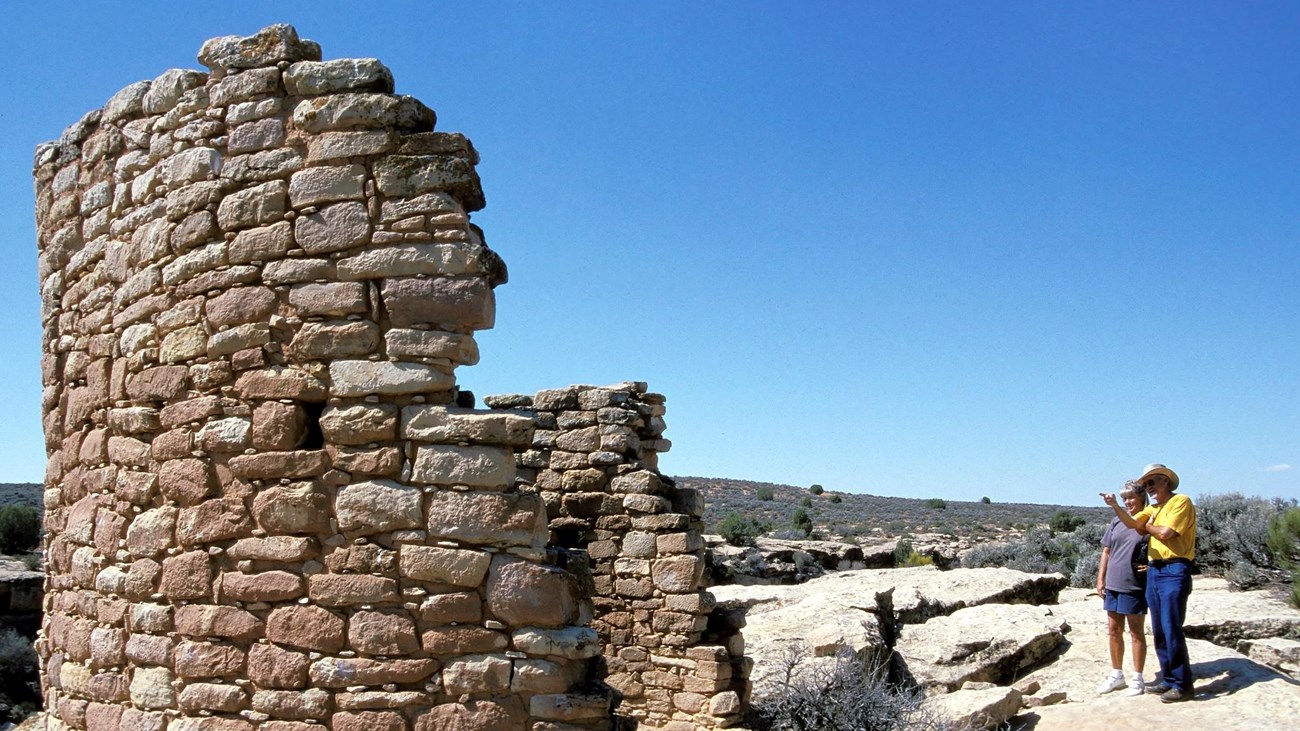
NPS photo Deep, Enduring Connections to LandThe NPS acknowledges, with respect, that Native people have been successful stewards of the land within the monument since time immemorial. The NPS understands that the park is located within the ancestral and traditional homeland of the Kaibab Band of Paiute Indians, Navajo Nation, Paiute Indian Tribe of Utah, Pueblo of Acoma, Pueblo of Laguna, Pueblo of Santa Ana, Pueblo of Santa Clara, Pueblo of Zuni, San Juan Southern Paiute, Southern Ute Indian Tribe of the Southern Ute Reservation, Ute Indian Tribe of Uintah and Ouray Reservation, and Ute Mountain Ute Tribe. Human PrehistoryPeople repeatedly occupied and abandoned Natural Bridges during prehistoric times. They first began using this area during the Archaic period, from the year 7000 BCE (Before Common Era) to 500 CE (Common Era). Only the rock art and stone tools left by hunter-gatherer groups reveal that humans lived here then. Around 700 CE, ancestors of modern Puebloan people moved onto the mesa tops to dry farm and later left as the natural environment changed. Three hundred years after their ancestors left, the farmers returned. They built homes of sandstone masonry or mud-packed sticks, both on the mesa tops and in alcoves in the cliffs. South facing caves provided passive solar heating and cooling. The farmers often chose sites near seep springs where water could be found. Styles of masonry, ceramic decoration and other artifacts suggest that the people here were related to those of the Mesa Verde region to the east. Influences are clearly evident from the Kayenta region to the southwest and the Fremont culture to the north. Like these people, the inhabitants of Natural Bridges left this area for the last time around A.D. 1270. Navajos and Paiutes lived in the area during later times, and Navajo oral tradition holds that their ancestors lived among the early Puebloans.

NPS photo European HistoryIn 1883, prospector Cass Hite wandered up White Canyon from his base camp along the Colorado River in search of gold. What he found instead were three magnificent bridges, sculpted from stone by water. In 1904, National Geographic Magazine publicized the bridges, and in 1908 President Theodore Roosevelt established Natural Bridges National Monument, creating Utah's first National Park Service area. Naming the BridgesSeveral names have been applied to the bridges. First named "President," "Senator" and "Congressman" by Cass Hite, the bridges were renamed "Augusta," "Caroline" and "Edwin" by later explorer groups. As the park was expanded to protect nearby Puebloan structures, the General Land Office assigned the Hopi names "Sipapu," "Kachina" and "Owachomo" to the bridges in 1909. Sipapu means "the place of emergence," an entryway by which the Hopi believe their ancestors came into this world. Kachina is named for rock art on the bridge that resembles symbols commonly used on kachina dolls. Owachomo means "rock mound," a feature atop the bridge's east abutment. Preserve and ProtectThese places are critically important to all of us. Mr. Hamana and others have their roots here. Hundreds of years of their history are written on the stone walls of these canyons. We frequently see these ruins and rock art only as curiosities, but perhaps they can teach us about our history and our future. Archeological sites are extremely fragile. They often hold spiritual significance for Native Americans. Their scientific value depends on artifacts remaining exactly where they are. All of these sites are protected by strictly enforced federal and state laws, notably the Antiquities Act of 1906 and the Archeological Resources Protection Act of 1979. These laws provide substantial fines and jail terms for site damage or the removal of even one small artifact such as a piece of pottery or part of an arrowhead. Remember, if an artifact is taken or rock art defaced, no fine or jail term can replace or repair it. Its spiritual, scientific and educational value is lost to all of us forever. If you find an archeological site, observe the following:

Visiting Archeology Sites: House Rules
Visiting a Southeast Utah park? Learn how to be a respectful guest during your visit to a cultural sites with these house rules. |
Last updated: April 18, 2025
